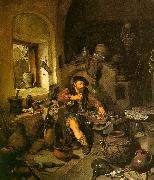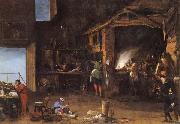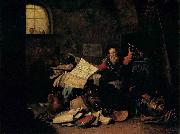Wholesale Oil Painting No Minimum |
|||||||||||
|
|
|||||||||||

|
|||||||||||
|
|
|
||||||||
Cornelis Bega1632-1664 Dutch Cornelis Bega Galleries Dutch painter, draughtsman and etcher. He was born into prosperous circumstances; his mother, Maria Cornelis, inherited half the estate (gold, silver, paintings, drawings and prints) and all of the red chalk drawings of her father, Cornelis Cornelisz. van Haarlem, a renowned Mannerist artist. Begas father was Pieter Jansz. Begijn (d 1648), a gold- and silversmith. Like other family members, Bega was probably Catholic. Houbrakens claim that Bega studied with Adriaen van Ostade is likely to be correct; this was probably before 24 April 1653, when Bega joined Vincent Laurentsz. van der Vinne in Frankfurt for a journey through Germany, Switzerland and France. Bega had returned to Haarlem by 1 September 1654, at which time he joined the Guild of St Luke; he was already a competent draughtsman, as indicated by his first extant dated work, Interior with a Nursing Mother (1652; Frankfurt am Main, Stedel. Kstinst.), and by a remarkable double portrait (Amsterdam, Rijksmus.) drawn by him and Leendert van der Cooghen in 1654. |
||||||||
|
|
||||||||
The Alchemist
The Alchemist Painting ID:: 45 |
1663
H.Shickman Gallery, New York 1663 H.Shickman Gallery, New York |
|||||||
|
|
||||||||
Napoletano, FilippoItalian, approx. 1587-1629 Italian painter and engraver. From 1600 until at least 1613 he was in Naples, where the naturalism of landscape painters from northern Europe, particularly Paul Bril, Goffredo Wals ( fl 1615-31) and Adam Elsheimer, influenced his early development. After 1614 he was in Rome and became acquainted with the landscapes and seascapes of Agostino Tassi. In 1617 Cosimo II de' Medici summoned him to Florence, where he worked closely with Jacques Callot. Filippo sketched in the Tuscan countryside, and pen-and-wash drawings such as the Landscape with a Rustic House (Florence, Uffizi) capture effects of bright sunlight. He developed a new kind of realistic landscape, showing small scenes that suggest the charm of country life; examples are the Country Dance (1618; Florence, Uffizi), the Mill (Florence, Pitti) and the Fair at Impruneta (Florence, Pitti). In 1620-21 he produced a series of etchings of Skeletons of Animals, dedicated to the scientist Johann Faber, and in 1622 twelve etchings of Caprices and Military Uniforms (signed Teodor Filippo de Liagno). |
||||||||
|
|
||||||||
|
|
The Alchemist
The Alchemist Painting ID:: 28959 |
mk65
Oil on canvas
36 1/4x53 1/8in
Pitti
mk65 Oil on canvas 36 1/4x53 1/8in Pitti |
||||||
|
|
||||||||
TENIERS, David the ElderFlemish Baroque Era Painter, 1610-1690 |
||||||||
|
|
||||||||
|
|
The Alchemist
The Alchemist Painting ID:: 95770 |
1640s
Medium oil on canvas
cyf 1640s Medium oil on canvas cyf |
||||||
|
|
||||||||
|
TENIERS, David the Elder Flemish Baroque Era Painter, 1610-1690 The Alchemist 1640s Medium oil on canvas cyf |
||||||||
|
|
||||||||
|
Prev Next
|
||||||||
|
|
||||||||
|
Related Paintings to TENIERS, David the Elder :. |
||||||||
|
|
||||||||
|
CONTACT US |



